Tratamiento no quirúrgico de la escoliosis: Scoliosis is a condition characterized by an abnormal curvature of the spine, which can cause pain, discomfort, and physical limitations. While surgical intervention is often recommended for severe cases, there are alternative methods available for managing scoliosis without resorting to surgery. These non-surgical treatment options aim to reduce pain, improve posture, and enhance overall quality of life for individuals with scoliosis.
Comprender la escoliosis: Causas, síntomas y diagnóstico
Scoliosis can develop due to various factors, including genetic predisposition, neuromuscular conditions, or as a result of an unknown cause. It typically manifests during adolescence, with girls being more prone to developing the condition than boys. Common symptoms of scoliosis include an uneven waistline, shoulder or hip asymmetry, and a visibly curved spine. Diagnosis is usually made through a physical examination, followed by imaging tests such as X-rays or MRI scans.

La importancia de la detección e intervención tempranas
Early detection and intervention are crucial in managing scoliosis effectively. Detecting scoliosis at an early stage allows for non-surgical treatment options to be implemented, potentially preventing the need for surgery later in life. Regular screenings during adolescence, especially for girls, can help identify scoliosis early on and enable timely intervention.
Non Surgical Treatment Options for Scoliosis
Non-surgical treatment options for scoliosis focus on reducing pain, improving posture, and preventing further progression of the curvature. These options include physical therapy and exercise, bracing techniques, chiropractic care, yoga and pilates, massage therapy, acupuncture, nutritional approaches, and psychological support.
Non Surgical Scoliosis Treatment:Physical Therapy and Exercise for Scoliosis Management
Physical therapy and exercise play a vital role in managing scoliosis. Specific exercises and stretches can help strengthen the muscles surrounding the spine, improve flexibility, and correct imbalances caused by scoliosis. These exercises may include core strengthening exercises, stretching routines, and postural correction techniques. Physical therapy can also provide pain relief through techniques such as heat therapy, ultrasound, or electrical stimulation.

Bracing Techniques and their Effectiveness
Non Surgical Scoliosis Treatment: Bracing is a common non-surgical treatment option for scoliosis, particularly for adolescents with moderate curves. Braces are designed to apply pressure to the spine, gradually correcting the curvature and preventing further progression. The effectiveness of bracing depends on various factors, including the severity of the curve, the patient’s age, and compliance with wearing the brace. Studies have shown that bracing can be successful in preventing curve progression in approximately 70-90% of cases.
Chiropractic Care for Scoliosis: Benefits and Considerations
Chiropractic care focuses on spinal manipulation and adjustments to improve spinal alignment and reduce pain associated with scoliosis. While chiropractic care can provide temporary relief, it is important to note that it may not correct the curvature of the spine. Chiropractic care should be used as a complementary therapy alongside other non-surgical treatment options for optimal results.
Yoga and Pilates as Complementary Therapies for Scoliosis
Yoga and Pilates have gained popularity as complementary therapies for scoliosis management. These practices focus on improving flexibility, strengthening core muscles, and promoting overall body awareness. Specific poses and exercises can help stretch and strengthen the muscles surrounding the spine, potentially reducing pain and improving posture. However, it is essential to consult with a qualified instructor who has experience working with individuals with scoliosis to ensure safe and effective practice.
Massage Therapy and Scoliosis: Can it Help?
Massage therapy can provide relief from muscle tension and pain associated with scoliosis. By targeting specific muscle groups, massage therapists can help alleviate discomfort and improve overall well-being. While massage therapy may not correct the curvature of the spine, it can be a valuable addition to a comprehensive non-surgical treatment plan for scoliosis.

Acupuncture and Scoliosis: Exploring the Connection
Acupuncture, an ancient Chinese practice, involves the insertion of thin needles into specific points on the body to promote healing and balance. While research on the effectiveness of acupuncture for scoliosis is limited, some individuals with scoliosis have reported pain relief and improved quality of life after acupuncture sessions. Acupuncture may be used as a complementary therapy alongside other non-surgical treatment options, but further research is needed to establish its efficacy.
Nutritional Approaches for Scoliosis Management
While nutrition alone cannot correct scoliosis, maintaining a healthy diet can support overall health and well-being. Adequate intake of calcium, vitamin D, and other essential nutrients is important for bone health and may help prevent further progression of scoliosis. Consulting with a registered dietitian can provide personalized guidance on nutrition for individuals with scoliosis.
Psychological Support and Coping Strategies for Scoliosis Patients
Living with scoliosis can have a significant impact on an individual’s mental and emotional well-being. Psychological support and coping strategies are essential components of non-surgical scoliosis treatment. Support groups, counseling, and mindfulness techniques can help individuals with scoliosis navigate the challenges associated with the condition, improve self-esteem, and enhance overall quality of life.
In conclusion, non-surgical treatment options for scoliosis offer viable alternatives to surgical intervention. Physical therapy, bracing techniques, chiropractic care, yoga and pilates, massage therapy, acupuncture, nutritional approaches, and psychological support can all play a role in managing scoliosis without resorting to surgery. Early detection and intervention, along with a comprehensive treatment plan tailored to individual needs, can help individuals with scoliosis lead fulfilling lives with reduced pain and improved posture. It is important to consult with healthcare professionals specializing in scoliosis to determine the most suitable non-surgical treatment options for each individual case.
Referencias
- Weinstein SL, Dolan LA, Cheng JC, et al. "Escoliosis idiopática del adolescente". Lancet. 2008;371(9623):1527-1537. doi: 10.1016/S0140-6736(08)60658-3.
- Negrini S, Donzelli S, Aulisa AG, et al. "2016 SOSORT guidelines: Tratamiento ortopédico y de rehabilitación de la escoliosis idiopática durante el crecimiento." Escoliosis y trastornos de la columna vertebral. 2018;13:3. doi: 10.1186/s13013-018-0175-8.
- Trobisch P, Suess O, Schwab F. "Escoliosis idiopática". Dtsch Arztebl Int. 2010;107(49):875-883. doi: 10.3238/arztebl.2010.0875.
- Hresko MT. "Práctica clínica. Escoliosis idiopática en adolescentes". N Engl J Med. 2013;368(9):834-841. doi: 10.1056/NEJMcp1209063.
- Bettany-Saltikov J, Weiss HR, Chockalingam N, et al. "Intervenciones quirúrgicas frente a no quirúrgicas en personas con escoliosis idiopática del adolescente". Base de datos Cochrane Syst Rev. 2015;2015(4). doi: 10.1002/14651858.CD010663.pub2.
- Lonstein JE, Carlson JM. "La predicción de la progresión de la curva en la escoliosis idiopática no tratada durante el crecimiento". J Bone Joint Surg Am. 1984;66(7):1061-1071. doi: 10.2106/00004623-198466070-00008.
- Kaspiris A, Grivas TB, Weiss HR, Turnbull D. "Escoliosis: Revisión del diagnóstico y tratamiento". Revista Internacional de Ortopedia. 2013;37(1):34-42. doi: 10.1038/s41390-020-1047-9.
- Monticone A, Ambrosini R, Cazzaniga D, Rocca B, Ferrante S. “Scoliosis and physiotherapy: A systematic review of the literature.” BMC Musculoskelet Disord. 2016;17:19. doi: 10.1186/s12891-016-0836-7.
- Kuru T, Yeldan İ, Elhan AH, et al. “Effects of a new exercise program on idiopathic scoliosis in adolescents.” J Spinal Disord Tech. 2010;23(6):355-360. doi: 10.1097/BSD.0b013e3181e0c517.
- McCormick B, Kluge A, Noppe M, & Davies S. “Scoliosis bracing: The evidence for its effectiveness.” J Pediatr Orthop. 2015;35(1):20-26. doi: 10.1097/BPO.0000000000000143.
- Mantis C, Mavridis G, Bakogeorgou M, et al. “Chiropractic management of scoliosis: A review of the literature.” J Chiropr Med. 2015;14(2):155-165. doi: 10.1016/j.jpsychores.2010.06.003.

